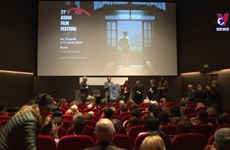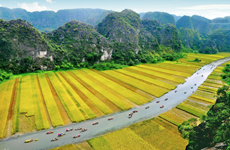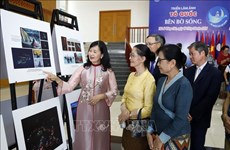Child photographers capture ethnic life
For the first time in his life, little Pao knew how a camera worked and the entire world unravelling behind it.
For the first time in his life, little Pao knew how a camera worked and the entire world unravelling behind it.
The eighth grade student has been provided with a pocket camera to capture what he sees in the community, as part of a Photo Voice Project supported by Oxfam and the Institute for Social Research, Economics and Environment (iSEE).
The project selected 15 students from the Man Than Ethinic Boarding Secondary School in the northern province of Lao Cai's Simacai district to use cameras to record moments in their day-to-day life.
"I photographed my brother and cousin carrying a pig home to prepare for a wedding. During weddings in our area, big pigs are served to the guests. This is a local tradition. A big pig can weigh around 80kg and needs two healthy young men to carry it with a hardwood tree pole," noted Pao, one of the best pupil photographers selected in the project.
"I also captured a lot of photographs related to food, eating, and daily life, such as my father taking care of the buffalo, working in the fields, and my friend helping out with the family work.
"I feel that through this project, I can now access new technology, learn about the surrounding life, and dare to communicate with the local authorities that I had previously thought my family could not reach," Pao asserted.
"After joining the project, I now really love photography. I want to become a professional photographer to earn money and help my parents when I grow up," he remarked.
Through the eyes and perspectives of amateur photographers, images about childhood games, school and family activities, and festivals are being widely showcased.
The young photographers turned their focus on important needs and desires of their lives, such as having ample rice and food to eat and water to drink, as well as social activities and school construction. Statistics reveal that of the 15,000 photographs captured by the students participating in the project, about 70 percent were food-related.
With the pictures taken by the local children, iSEE offers us a glimpse into their daily lives and culture, stated Hoang Huy Thanh, an official of iSEE.
"We chose three provinces and in each province, we selected one or two village communities. We worked with the local heads of each village by holding meetings in order to introduce them to the project. We proposed each community to select six-eight people to carry out this programme," Thanh elaborated.
"Each person was then given a camera and some training on cultural values, on how to use the camera to capture photographs. They were not required to capture pictures as photographers, but rather to take authentic images of the daily ongoings around them and explain them. The project helps in the process of self-appraisal through story-telling via images," Thanh explained.
"Those who participated in the Photo Voice were able to click several wonderful pictures. Once these images were printed, they were especially happy to see their community and relatives portrayed and remembered", Thanh added.
"Until now, five ethnic pupil groups have conducted basic and preliminary research, and plans include showcasing the best selected photographs in an exhibition in Hanoi, on June 1.
"At first, the children participated timidly. Gradually, the project brought more self-confidence, better self-reliance, and a feeling that they can achieve anything," noted Nguyen Truong Giang, a lecturer in visual anthropology at the University of Social Sciences and Humanities in Hanoi, who helped instruct them.
"Before the project commenced, they believed that taking a picture to tell a story is only the work of journalists and photographers. With this programme, we empowered them to see that they can capture photographs to tell their stories and stand up for their rights and the rights of all children," Giang explained.
"This programme has a great impact in changing behaviour. Now, the children dare to say what they think and dare to dream. Many of them didn't even have a dream. They just wanted to have something to eat and go to school," noted a representative of the local Education and Training Department.
"Now, they believe they can become photographers, doctors, policemen, administrators, and policy makers. Photo Voice has instilled a life-changing dream in them," he emphasised.
The programme continues to care for students from the ethnic minority groups, Raglan (Ninh Thuan), Mnong (Dak Nong), and Mong (Lao Cai) since early last year.
"We hope that the government and social organisations can implement many more projects to help children develop a sense of ethnic pride and introduce appropriate reforms. Photo Voice is an impressive project to improve the quality of local and practical education. I think we need to replicate this project across the country," stressed Le Duc Ha, the headmaster of the school.-VNA
The eighth grade student has been provided with a pocket camera to capture what he sees in the community, as part of a Photo Voice Project supported by Oxfam and the Institute for Social Research, Economics and Environment (iSEE).
The project selected 15 students from the Man Than Ethinic Boarding Secondary School in the northern province of Lao Cai's Simacai district to use cameras to record moments in their day-to-day life.
"I photographed my brother and cousin carrying a pig home to prepare for a wedding. During weddings in our area, big pigs are served to the guests. This is a local tradition. A big pig can weigh around 80kg and needs two healthy young men to carry it with a hardwood tree pole," noted Pao, one of the best pupil photographers selected in the project.
"I also captured a lot of photographs related to food, eating, and daily life, such as my father taking care of the buffalo, working in the fields, and my friend helping out with the family work.
"I feel that through this project, I can now access new technology, learn about the surrounding life, and dare to communicate with the local authorities that I had previously thought my family could not reach," Pao asserted.
"After joining the project, I now really love photography. I want to become a professional photographer to earn money and help my parents when I grow up," he remarked.
Through the eyes and perspectives of amateur photographers, images about childhood games, school and family activities, and festivals are being widely showcased.
The young photographers turned their focus on important needs and desires of their lives, such as having ample rice and food to eat and water to drink, as well as social activities and school construction. Statistics reveal that of the 15,000 photographs captured by the students participating in the project, about 70 percent were food-related.
With the pictures taken by the local children, iSEE offers us a glimpse into their daily lives and culture, stated Hoang Huy Thanh, an official of iSEE.
"We chose three provinces and in each province, we selected one or two village communities. We worked with the local heads of each village by holding meetings in order to introduce them to the project. We proposed each community to select six-eight people to carry out this programme," Thanh elaborated.
"Each person was then given a camera and some training on cultural values, on how to use the camera to capture photographs. They were not required to capture pictures as photographers, but rather to take authentic images of the daily ongoings around them and explain them. The project helps in the process of self-appraisal through story-telling via images," Thanh explained.
"Those who participated in the Photo Voice were able to click several wonderful pictures. Once these images were printed, they were especially happy to see their community and relatives portrayed and remembered", Thanh added.
"Until now, five ethnic pupil groups have conducted basic and preliminary research, and plans include showcasing the best selected photographs in an exhibition in Hanoi, on June 1.
"At first, the children participated timidly. Gradually, the project brought more self-confidence, better self-reliance, and a feeling that they can achieve anything," noted Nguyen Truong Giang, a lecturer in visual anthropology at the University of Social Sciences and Humanities in Hanoi, who helped instruct them.
"Before the project commenced, they believed that taking a picture to tell a story is only the work of journalists and photographers. With this programme, we empowered them to see that they can capture photographs to tell their stories and stand up for their rights and the rights of all children," Giang explained.
"This programme has a great impact in changing behaviour. Now, the children dare to say what they think and dare to dream. Many of them didn't even have a dream. They just wanted to have something to eat and go to school," noted a representative of the local Education and Training Department.
"Now, they believe they can become photographers, doctors, policemen, administrators, and policy makers. Photo Voice has instilled a life-changing dream in them," he emphasised.
The programme continues to care for students from the ethnic minority groups, Raglan (Ninh Thuan), Mnong (Dak Nong), and Mong (Lao Cai) since early last year.
"We hope that the government and social organisations can implement many more projects to help children develop a sense of ethnic pride and introduce appropriate reforms. Photo Voice is an impressive project to improve the quality of local and practical education. I think we need to replicate this project across the country," stressed Le Duc Ha, the headmaster of the school.-VNA













